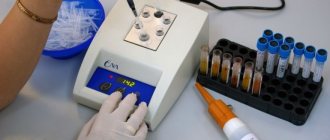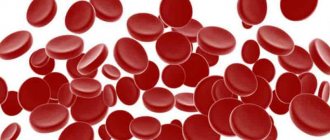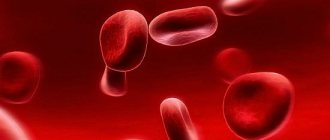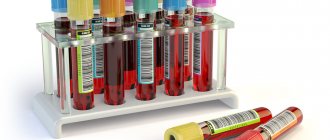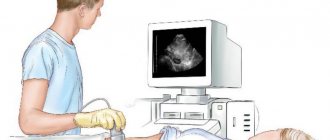A blood test in children has its own specific features, primarily related to the fact that the child’s body is still developing, so many basic indicators may have significant differences from the adult norm.
For a child, a general blood test is mandatory from the first day of his birth.
When examining a child's blood fluid, the first things that are taken into account are lymphocytes and monocytes, which can tell a lot about the overall health.
General information
Despite its simplicity and accessibility, a clinical general blood test is the most informative, allowing one to identify many pathological conditions in a child’s body, including helminths.
This study is carried out for children, regardless of their age. The results of the analysis provide the doctor with the most complete picture of the baby’s general health.
During the study, lymphocytes, monocytes and many other indicators of blood fluid are determined, and their deviations from the norm are observed.
Despite the fact that this study does not require preliminary preparation, some conditions will still have to be met.
In order for lymphocytes, monocytes and other indicators of blood fluid to show their reliable values, the analysis should be performed in the morning and only on an empty stomach.
The last meal is allowed no later than eight hours before submitting the material for research. Immediately before the analysis itself, you are allowed to drink water, but only still water.
In addition, parents should make sure that on the eve of the test the child does not eat fatty or fried foods, and also does not take various medications.
You should put your baby to bed early and try not to worry him before taking the test.
The test can be prescribed to children as a preventative measure, however, there are a number of specific indications on the basis of which the doctor must refer a small patient for testing.
Thus, lymphocytes and monocytes in a child’s blood should be checked when he complains of feeling unwell.
It is recommended to undergo analysis even when a young patient has a seemingly simple disease that continues over a long period of time.
Blood fluid examination is also carried out to monitor pre-prescribed therapy, as well as to assess the severity of the baby’s condition for various diseases.
The results of such a study can tell a lot about the nature of the complications that appear against the background of the underlying pathology.
Blood fluid for general clinical analysis is taken directly from capillary blood. To do this, the laboratory assistant makes a shallow puncture of the finger on the hand.
In turn, in infants the material can be taken from the heel. Next, the blood material is placed on a special glass, a certain reagent is added to it, the whole thing is covered with another glass and sent for research to the laboratory.
If everything is done correctly, a general blood test can with a high probability reveal various diseases, parasites (for example, helminths, lamblia) and other pathologies in the body of children.
How to treat
Treatment of poor clotting is a long process. A full examination is required, on the basis of which the doctor prescribes a course of treatment. Most often, treatment measures include:
Elimination of vitamin K and calcium deficiency. Elimination of disorders associated with the functioning of platelets in the patient’s body. Donor blood transfusion. The use of medications for the normal functioning of fibrinogen. Eating foods high in vitamin K, calcium, and amino acids. First of all, these are dairy products (cottage cheese, kefir, sour cream, cheese, etc.)
It is important to focus on eating leafy vegetables (spinach, green onions, white cabbage), meat, and fish.
After consulting with a doctor, you can turn to traditional medicine. Doctors recommend drinking decoctions of nettle, yarrow, and pine nut shells. Black currant leaves, arnica, and barberry fruits will also help.
As a result, bleeding disorders are a serious problem. In each specific case, a complete and comprehensive examination gives a clear picture of the disease. Based on this, the doctor draws up a course of treatment.
Blood is the life-supporting internal environment of the body. It performs many functions: delivery of oxygen and nutrients; removal of decomposition products; regulation of heat exchange; transport of active enzymes and hormonal substances; protective function in the form of phagocytosis and hemostasis. But what to do if it’s bad, what could be the consequences and causes of such a pathology.
In a severe form of disorder of the coagulation system - von Willebrand disease, characteristic subcutaneous hemorrhages are formed, hemorrhages into the periarticular bursa are frequent, and internal bleeding is possible. Von Willebrand disease is inherited, but there are also acquired forms. They often occur as a complication and can be provoked by rheumatoid diseases and some heart pathologies.
Decryption features
According to the results of a blood test, some indicators may be increased or, conversely, decreased.
In addition, a clinical analysis of blood fluid can reliably show the presence of parasites such as helminths in children’s bodies.
There is a special table of blood fluid indicators in their normal state, and the values of all the main indices obtained during the study are compared against it.
The laboratory especially carefully studies lymphocytes, which are the main cells of the immune system in children.
Lymphocytes are primarily designed to produce specific antibodies that can effectively fight cells harmful to the body.
Depending on the age of the baby, lymphocytes may change their normal values.
Lymphocytes reach their highest levels in one-year-old children, then they begin to gradually decrease their values, and by adulthood their percentage ranges from 25 to 35.
Monocytes are also the most important elements in the blood of children. Monocytes are the smallest cells, the so-called “white blood”.
Monocytes in the blood fluid perform the function of absorbing a wide variety of harmful microorganisms.
Monocytes are expressed as a percentage; on average, their norm in children ranges from 2 to 12%.
If both of these indicators are elevated, this indicates that some pathological processes are occurring in the baby’s body.
Also, in the process of examining the baby’s blood, the quantitative characteristics of red blood cells are carefully checked in the laboratory.
This essential element of blood fluid is responsible, first of all, for the delivery of oxygen to all cells and internal organs.
The analysis also determines the level of hemoglobin, which is part of red blood cells.
The color index of the blood fluid is carefully assessed, which changes somewhat with increasing age of the child.
Color
If we turn to the standards for urine analysis in women, we will see that the color of urine should range from light straw to amber. It is determined by the blood pigments contained in the fluid and the concentration of other substances dissolved in it.
If a person drinks a lot of liquid, then, accordingly, the color of his urine will be lighter. Morning urine is somewhat darker than daytime and evening urine, which is associated with nighttime abstinence from urination.
It is important to note that many foods and medications can change the color of urine, so deviations from the normal color are also not pathological. For example, cephalosporins can turn urine almost light red, sulfonamides - brown, riboflavin - bright yellow.
But there are also pathological reasons for poor urine analysis in women:
- Brown, yellow-green, beer colors. Diseases of the gallbladder and liver.
- Dirty red color. Kidney diseases. The color indicates the presence of blood in the urine.
- Milky white. The concentration of phosphates and fats in the body is high.
- Almost black color. It is observed with the destruction of red blood cells and hemolytic anemia.
- Almost colorless urine. Indicates polyuria, pyelonephritis, diabetes mellitus and diabetes insipidus.
The meaning of some indicators
It is extremely important for children to have a blood test from the first days of their birth. Literally immediately after birth, an analysis is done to detect a variety of genetic pathologies.
In this case, timely detection of various abnormalities can save the life of a little person.
Blood tests are especially often performed in the first year of children's lives. This is done in order to respond in time to the possible development of a particular pathology.
A poor test result at this age allows timely initiation of treatment therapy. As a rule, if the study shows a poor result, the cause of the disease is first determined.
A poor test result shows that monocytes and lymphocytes are simultaneously elevated in the blood.
In this case, we can say that if monocytes along with lymphocytes are elevated, then a viral infection is most likely present in the body.
In addition, some elevated blood indices indicate that there are helminths in the baby’s body.
In this case, helminths can be identified by changes in the number of leukocytes. Also, in some cases, activated thromboplastins are determined, which characterize blood clotting.
Blood tests are important for children of any age. It allows you to timely identify various pathologies and diseases, even if they are latent.
You should donate blood not only for various ailments of the baby, but also as a preventive measure.
A bad blood test is not a death sentence. After all, there can be many reasons for such results. Not all of them indicate abnormalities in the functioning of the body or the presence of pathologies. Doctors often prescribe laboratory tests, because in order to correctly determine the disease, one examination of the patient is not enough. His blood can tell a lot about a person’s health. Any problems in the body will immediately affect its performance. Therefore, for almost any disease it is recommended to do a blood test.
Having heard from a doctor about not very good results, many people immediately get scared. In fact, a bad analysis is not yet a reason to panic. This usually happens if some deviations from the norm of the main indicators are detected. The reason for a poor analysis may be, for example, improper preparation of the patient for the test.
How to influence test results
If deviations from the norm are not significant and are within the permissible deviations, then they can be corrected. You can improve your test results by changing your diet, rest schedule, and physical activity. You can also get good results by adding preventive herbal preparations to your daily diet.
Factors influencing urine test results:
- diet;
- quantity and quality of fluid consumed;
- physical activity regimen;
- taking vitamin and biologically active supplements.
Every day a person needs to consume a sufficient amount of proteins, fats and carbohydrates in appropriate proportions. Insufficient protein intake causes a shift in the acid balance of urine towards alkalization and causes the appearance of amorphous phosphates in the sediment. Excessive protein consumption can lead to the appearance of acetone and ketone bodies in samples.
Each person should consume on average 1.5 - 2 liters of fluid during the day. The consumption of tea and coffee cannot be taken into account in the total amount of water intake, since these drinks additionally dry out the body. Natural coffee has a diuretic effect and leads to additional fluid loss.
Do not overuse mineral waters. It is necessary to understand that all mineral waters can be divided into several types, each of which has its own indications for use.
Types of mineral waters:
- healing mineral water;
- therapeutic and prophylactic mineral water;
- table mineral water.
Therapeutic mineral waters contain a large amount of minerals and salts and can be used strictly according to indications. Medicinal waters can only be consumed in certain quantities; they are not intended for daily use. Incorrect or too frequent consumption of mineral waters often causes an increase in the salt content in the sediment. Therapeutic and prophylactic waters also have a number of contraindications. Table mineral waters are best suited for daily use.
Information about the level of mineralization, as well as the category of mineral water, must be specified on the label. Sometimes the bottle only indicates the level of mineralization, by which one can judge which category the mineral water belongs to.
Water mineralization levels:
- table water – mineralization level up to 1 g/l;
- therapeutic and prophylactic water mineralization up to 10 g/l;
- medicinal water – mineralization more than 10 g/l;
Only table water is suitable for daily use. In order for the results of urine tests to be normal, it is necessary to adhere to a balanced diet and drink enough water.
Poor analysis and improper preparation
Having received a referral for a laboratory test, you must carefully listen to the doctor’s recommendations about the rules for taking it. Almost any blood test must be taken on an empty stomach. If a biochemical analysis or hormone test is prescribed, you must not eat at least 8-10 hours before going to the laboratory. After having a hearty dinner after midnight, you cannot go and donate blood. The result will be distorted. To take a general blood test, it is enough to not eat anything for the last 3 hours. It is often difficult for parents to refuse their children. After all, they cry so pitifully and ask so touchingly. It seems that this is not food - cookies or a bun. However, one must remain steadfast, since even a small sweet with a cup of tea can blur the picture.
Before taking a blood test for sugar, it is strictly forbidden to eat sweets. Chewing gum, if it contains sugar, is quite capable of ruining the result. It is better not to take risks and not to consume products that are questionable. A small amount of sweets eaten can raise blood glucose levels to pathological levels. A jump in the indicator after eating foods with sugar is quite normal. But to understand whether this is a normal condition, you need to avoid sweets on the eve of the tests. It is wiser to wait a little longer than to donate blood again. You are allowed to drink some clean water. The day before the test, it is recommended to refrain from eating fatty, salty, fried, smoked and spicy foods. Immediately before the procedure, you need to sit quietly and catch your breath. Excitement or fast walking may affect the test result.
Why does blood flow poorly from a vein during sampling?
The procedure for collecting blood from a vein is familiar to most people and is not difficult. But there are times when blood fluid does not flow from the vein. If blood does not flow when the needle is inserted into the vein, this circumstance makes it very difficult to obtain the required volume for the study. And besides, it causes anxiety for the patient’s health. But there's no need to worry too much. There are some reasons that affect the viscosity of the blood flow, which are also quite possible to eliminate. To find out why blood does not flow from a vein during sampling, you need to consider several factors that affect the consistency of the blood flow.
Basic indicators
If everything is done correctly, but the result is unimportant, there is no need to rush to get upset.
A poor analysis does not necessarily indicate a serious pathology.
It all depends on the degree of deviation from the norm and its significance for diagnosis. The reasons for the failure may be different. For example, a temporary surge under the influence of external factors or taking medications. A recent illness also leaves its mark on the characteristics of the blood.
Salts
Salts in a woman’s urine are often not a deviation from the norm. It all depends on the patient’s condition and the reason for which she was prescribed the test. Therefore, you should trust a specialist to decipher it, and not do it yourself.
Additionally, it is necessary to highlight such a phenomenon as urates in a woman’s urine. These are soluble potassium and sodium salts contained in uric acid. The appearance of these inclusions in the urine is associated with the disease uraturia or uric acid diathesis.
These are stones (by nature they are uric acid salts) of a light yellow or reddish hue. They have a round shape and are rough. Their formation is caused by a love of strong tea, sharp cheeses, spinach, tomatoes, smoked products, and excessive consumption of meat and offal. Causes the formation of urates and alcohol abuse. Uric acid diathesis can be provoked by constant stressful situations, hereditary predisposition, past pathologies - hepatitis, pyelonephritis, pancreatitis.
In pregnant women, another reason for the formation of urates is identified - toxicosis, which often results in dehydration. Uraturia in women can also be caused by an infectious disease of the genitourinary system.
If the nature of the pathology is infectious, then the doctor prescribes treatment against the causative agents of the disease. In all cases, the main component of treatment will be diet, exclusion of harmful foods from the diet, and stabilization of the water regime.
Reasons for deviations
In their practice, pediatricians often encounter low hemoglobin in children. This indicator indicates an insufficient percentage of iron in the body. Hemoglobin transports oxygen from the lungs to the tissues. If there is not enough of it, then the body experiences oxygen starvation.
It is quite easy to increase your hemoglobin level. It is necessary to include more iron-rich foods in your diet. And walk longer in the fresh air. In pathological conditions, treatment with iron-containing drugs is prescribed. But hemoglobin can also be elevated. This is a signal for additional research. Elevated hemoglobin may be a signal of a possible disease. Although in some cases there are natural fluctuations in hemoglobin levels that do not require any treatment.
A low number of erythrocytes (red blood cells) often indicates anemia, problems with hemoglobin synthesis. Treatment is a balanced diet and fresh air, as in the case of low hemoglobin. At the same time, blood loss may also be the cause of a decrease in the concentration of red blood cells. The red blood cell count is higher than normal when the child does not drink enough fluids. This is a sign of dehydration. In this case, you need to offer children various drinks more often. Sodas and juices must be strictly dosed, giving preference to clean water, homemade compotes, fruit drinks and weak tea. But the cause may not only be dehydration. This deviation occurs with fairly serious diseases.
Hematocrit determines the thickness of blood. It should be assessed together with hemoglobin and red blood cell values. A decrease in hematocrit may confirm that the child has anemia. In some cases, a low hematocrit may be normal. Exceeding the norm of this indicator may indicate a lack of oxygen. For example, when traveling in the mountains. But, most likely, this is a sign of a disease, and additional research is needed.
Platelets are responsible for stopping bleeding. If there are many of them, the blood becomes too thick. It is diluted by eating sour berries, garlic and lemon or using medications, depending on the reasons that caused the deviation. A low platelet count prevents wounds from healing. Abnormal platelets are not a good result in any case. Treatment is required here.
White blood cells are the warriors of the immune system. A low concentration of white blood cells indicates the body's weak ability to resist. This happens as a result of some disease or due to a naturally weak immune system. The doctor may prescribe immunostimulants. An increased concentration of white blood cells is a sign that the body is fighting a serious disease. Such an organism requires serious medical support.
Lymphocytes are a type of white blood cell. They fight bacteria and viruses. If there are too few of them, then the forces are unequal. The disease is serious and we need help. If there are a lot of them, then most likely the cause of the disease is viruses. In children, an increased concentration of lymphocytes is recorded when diagnosing “childhood” diseases: mumps, chickenpox, measles, whooping cough, rubella and scarlet fever.
Monocytes are the orderlies of the circulatory system. They destroy foreign particles, pathogens, and dead cells. There are few monocytes in anemia. But if there are a lot of them, this is not a good sign. This picture is observed in fairly serious diseases.
Erythrocyte sedimentation rate reflects the concentration of blood proteins. Deviation from the norm of this indicator is not necessarily a sign of disease. But it is taken into account in the context of other blood parameters. If they are normal, then ESR deviations are not taken into account.
A slight increase or decrease in itself is not a cause for concern. This may be temporary and not pose a health threat. The degree of deviation also matters. A slight upward deviation indicates a slight inflammatory process, while a significant one indicates serious problems in the body. A low reading on this indicator may indicate malnutrition or heart problems. But you need to know that young children have slightly different standards. A reduced ESR in a baby is the norm.
Why does blood flow poorly from a vein during sampling?
The procedure for collecting blood from a vein is familiar to most people and is not difficult. But there are times when blood fluid does not flow from the vein. If blood does not flow when the needle is inserted into the vein, this circumstance makes it very difficult to obtain the required volume for the study. And besides, it causes anxiety for the patient’s health. But there's no need to worry too much. There are some reasons that affect the viscosity of the blood flow, which are also quite possible to eliminate. To find out why blood does not flow from a vein during sampling, you need to consider several factors that affect the consistency of the blood flow.
What to do if tests are bad
As it turns out, bad blood tests are not a reason to worry right away. Disorders of the hematopoietic system are not always associated with pathologies and “terrible” diseases. But a bad blood test is definitely a reason to see a doctor. Only a specialist can decipher the research results. He considers the picture as a whole, based on external examination data, the child’s complaints, the dynamics of the disease and the results of laboratory tests. A blood test is only part of the overall examination.
All this data together determines the diagnosis, and the doctor makes a decision on treatment or additional research.
What does a bad blood test mean and how to deal with it?
Blood tests, as one of the simplest and most common diagnostic methods, accompany a person throughout his life, starting from birth. We are sent to take tests during preventive examinations and during illnesses, after which everyone can hear: “Your blood test is bad!” In order to react correctly to such news, first of all, you should know what we are talking about.
What are the symptoms of poor clotting?
Coagulation is an important process that occurs in the body, which helps prevent heavy bleeding that occurs when the integrity of the vascular network is violated. Since, with poor coagulation, the cells that make up the body begin to experience “oxygen starvation,” this contributes to the emergence of severe pathologies that are dangerous to health.
Other symptoms of poor coagulation include:
- weakness;
- frequent dizziness;
- the occurrence of bruises with any minimal injuries;
- constant bleeding from the nasal cavity;
- inability to stop bleeding in case of any violation of the integrity of the skin.
In women and older girls, heavy monthly bleeding may be a sign of coagulation disorders.
Types of urine tests in children
In addition to the well-known general analysis, there are many other methods for examining urine. They also reveal abnormalities in the functioning of the urinary system. In pediatric practice, to clarify the diagnosis, the following types of qualitative and quantitative urine tests are prescribed:
- according to Nechiporenko;
- according to the Amburger method;
- according to Adiss-Kakovsky;
- according to Sulkovich;
- according to Zimnitsky;
- alpha-amylase test.
Urinalysis according to Nechiporenko
This is a simple and informative research method. It consists of counting the number of leukocytes, red blood cells, and casts in 1 ml of urine.
The morning (first) average portion of urine is collected for analysis. Its volume should be at least 10 ml. Laboratory assistants count the indicated cells in 1 ml of biomaterial. Normally, the number of white blood cells should not exceed 4 thousand, erythrocytes - 1 thousand, cylinders - 250 in 1 ml.
Urinalysis using the Amburger method
This technique is similar to the previous study. The same shaped elements and the same normative units are defined. But when analyzing according to Amburge, the number of elements released in 1 minute is examined.
The day before collecting the material, you should limit your fluid intake; you should not drink at all at night. After waking up, the child urinates in the toilet (or in a container for general analysis). The exact time of the micturition is recorded. Strictly after 3 hours, you should collect the entire portion of urine and send it for analysis.
Urine examination according to Addis-Kakovsky
To conduct this study, it is necessary to count the number of casts and formed elements in daily urine. On the eve of collecting the material, the child should be fed food rich in protein, and the amount of fluid consumed should be reduced. Before going to bed at night, the time of the last micturition is recorded. After waking up, urine is collected in one container for 12 hours.
Considering that formed elements can disintegrate during long-term storage, the collection time is limited, and laboratory assistants recalculate per day. When interpreting the analysis, it is taken into account that the number of leukocytes should not exceed 4 million, erythrocytes - 1 million, cylinders - 20 thousand.
Sulkovich test
This test is a screening test to determine calcium excreted in the urine. For analysis, a morning portion of urine is collected. Then, under laboratory conditions, Sulkovich's reagent based on oxalic acid is added to the collected material. Calcium forms an insoluble precipitate with the reagent, which causes turbidity.
The degree of turbidity is expressed as “+” and determines the amount of calcium. 1-2 crosses are considered normal indicators.
Urine analysis according to Zimnitsky
This study allows you to determine the filtration and concentration function of the kidneys. At 6.00 the child urinates for the first time into a clean container. You need to write down the time on it. Then, every 3 hours throughout the day, urine portions are collected into separate labeled jars.
Meals during the study are normal. If there is a need to pee earlier, the child does it in the next container. The next portion is going there. To interpret the results, nighttime, daytime and daily diuresis are calculated. They also measure the density of urine in each portion.
Testing the level of alpha-amylase in urine
Alpha amylase is secreted by salivary and pancreatic cells to break down complex carbohydrates. Its level in urine should not exceed 17 U/h. There are two ways to determine the enzyme in urine: portion and daily.
In order to collect portioned urine, it is necessary to measure and record the volume of material obtained during the first urination after a night's sleep. Then 30 ml is poured into a sterile container, and the time between the last evening micturition and the first morning micturition is recorded.
When collecting daily urine, the first (morning) portion is poured into the toilet, and all the rest are collected in a container that is stored in the refrigerator. After a day, the daily amount of material and the research time are measured and recorded. After this, 50 ml is poured into the container, which must be delivered to the laboratory.
Reasons for this violation
The blood clotting effect is provided by fibrinogen, which is included in the blood serum. Thanks to its presence, fibrin blood clots quickly form, which help stop bleeding. Today doctors identify a large number of reasons that can disrupt this phenomenon.
When a person is completely healthy and his organs and systems are functioning normally, the blood that begins to flow from wounds after damage to the skin quickly stops. If this does not happen, or if hematomas of unknown origin often appear on the body, then it is worth undergoing a medical examination to determine the causes of this condition and, if necessary, receive effective treatment.
In order to timely diagnose the presence of a pathology of the blood coagulation system, you should always pay attention to the state of your health and answer the following questions:
- What causes bruises?
- How does the body react to wounds and cuts to the skin?
- How long do you have to wait until the bleeding stops?
- Do your gums bleed?
Since children do not always pay attention to what is happening to them, parents should monitor their health status themselves. This will prevent the development of this disorder, which can ultimately cause severe blood loss, as well as other problems.
Causes of bleeding disorders:
- active synthesis of anticoagulants in the body, which prevent blood from clotting normally;
- liver pathologies;
- course of infectious diseases;
- impaired immunity;
- genetic predisposition;
- nervous disorders;
- frequent occurrence of stressful situations;
- obesity;
- improper or infrequent nutrition.
If it is not possible to stop the bleeding for a long time, the child may experience problems with the functioning of internal organs.
Every result has a reason
Systematizing many cases of receiving a bad blood test, we can identify two possible reasons for obtaining such results. There is a pathology in the body or the patient has violated the basic requirements of preparing for blood donation.
In any of these options, a re-analysis should be done. For the purity of the experiment, you can donate blood in some other laboratory. In doing so, consider the following simple rules:
- Almost all tests must be taken on an empty stomach, that is, 8-12 hours after eating, so blood sampling is usually practiced in the morning. Food can change the composition of the blood for the worse and increase blood glucose levels. A general analysis can be done 3 hours after eating.
- In the morning you can only drink water, and still water. Sweet drinks (tea, coffee, compote) are excluded before donating blood.
- On the eve of going to the laboratory, you should refrain from alcohol, fried, fatty, spicy, smoked, salty and sweet foods.
- The results of the study may be negatively affected by taking medications. If possible, it is better to avoid them.
- On the eve of the test, it is not recommended to organize sports training, visit the sauna, or experience great physical and nervous stress.
- On the day of the analysis, before visiting the laboratory, you cannot do an ultrasound, x-rays, or any physical procedures.
- If the patient smokes and does not want to get a pathological increase in hemoglobin, then at least 2 hours before blood sampling you will have to give up cigarettes.
- The condition of the blood is influenced by many different factors. If you were in a hurry or worried, before entering the laboratory, calm down, sit and meditate for about 20 minutes, then the results will be much better.
- When taking a general clinical test, make sure that the finger from which blood is taken is free of wounds and abrasions.
- Cancel your trip to the laboratory if you feel unwell, feel generally unwell, or feel tired.
- You need to keep in mind that the analysis may be bad if you have recently been ill and are in the process of recovery. In this case, a repeat study should be done no earlier than after a few weeks.
- Have you followed all the instructions, but the analysis results are again disappointing? No problem. The doctor will prescribe treatment and everything will be fine.
Hemorrhagic disease in infants
Hemorrhagic disease of newborns is a pathology based on a blood clotting disorder (in medicine this process is called coagulopathy), which in most cases is caused by a lack of vitamin K in the body and manifests itself in the first days of a baby’s life. Externally, the disease is expressed by increased bleeding and bruising.
According to statistical data, the incidence of newborns in our country ranges from 0.25-1.5%. In those countries where there is a preventive program aimed at administering vitamin K supplements to children after birth, the problem has been reduced to almost zero - 0.01% of infants or fewer become ill.
About vitamin K and its role in the body
The very name of the vitamin, designated by the letter K, comes from the phrase “coagulation factor,” which directly indicates its most important function.
It has been proven that blood clotting requires at least 10 active proteins, 5 of which are synthesized with the participation of vitamin K. The liver needs it to produce prothrombin, a substance that allows blood to thicken.
Vitamin K is necessary not only for the circulatory system, it also helps retain calcium in bone tissue.
Without vitamin K, normal functioning of the circulatory system is impossible.
In adults, a deficiency of this vitamin is rare, since it is produced in sufficient quantities by intestinal bacteria, and it is also present in many vegetables without breaking down after heat treatment. But in babies, deficiency is possible for a number of reasons, then hemorrhagic syndrome develops in newborns.
Causes of hemorrhagic disease
Let's look at the situations in which K-hypovitaminosis occurs:
- Intestinal dysbiosis. It is associated either with the use of antibiotics, or with physiological reasons, when the bacterial intestinal flora simply did not have time to develop. Its production begins only on the 4th-5th day of life, provided that the colonization of bacteria occurs unhindered.
- The fetus has a small supply of the vitamin. Vitamin K passes through the placental barrier poorly, so its content in a newborn is half that of an adult.
- Its content in milk is low. The fact is that both breast and cow's milk do not cover the daily requirement for the vitamin. Therefore, breastfeeding can become a provoking factor in the development of hemorrhagic disease. But this does not mean that you need to give up breastfeeding, there is simply a need for a small nutritional correction.
The following factors can aggravate the situation:
We recommend reading: The first week of a newborn’s life
- during pregnancy the woman took anticoagulants or anticonvulsants;
- presence of liver or intestinal diseases;
- prematurity of the child;
- gestosis and toxicosis of a pregnant woman;
- the baby was put to the breast late;
- if the baby has been on parenteral nutrition for a long time;
- malabsorption syndrome was detected - when the process of absorption of nutrients in the intestine is impaired; the main symptom is diarrhea for more than 7 days;
- pathologies of the biliary tract (obstruction or complete absence).
Forms of the disease
There are primary and secondary hemorrhages. Primary is said to be when the fetus initially had a deficiency of the vitamin, and its supply through mother’s milk is minimal. By the 5th day, the deficiency can be compensated for by its intestinal production.
The secondary form is diagnosed if liver lesions are present, when the synthesis of polypeptide precursors of plasma factors (PPPP) is impaired.
The disease is classified according to the time of onset:
- early - bleeding makes itself felt on 1, maximum 2 days after birth;
- classic - appears on days 3-5;
- late - occurs at any time during the first 8 weeks of life.
Symptoms
In the early form, hemorrhages often begin in the prenatal period. The child is born with intracranial, pulmonary and skin hemorrhages. Internal bleeding into the liver, spleen, adrenal glands, as well as into the abdominal organs, and vomiting with blood are typical.
The disease is characterized by cutaneous hemorrhagic effusions
The classic reaction is characterized by the presence of blood in the stool and vomit around the 7th day of life.
Poor coagulation is visible in the bleeding of the navel, in the long-term non-healing in case of circumcision of the foreskin in boys, in nosebleeds, cephalohematoma on the head and bruises on the skin.
The wounds do not heal for a long time after injections. In severe cases, anemia and hemorrhagic damage to internal organs are detected.
The late form develops as a result of liver diseases and dysfunctions of the gastrointestinal tract along with breastfeeding. Leading symptoms:
- hematemesis (bloody vomiting);
- in half of the cases there are intracranial hemorrhages and cephalohematomas;
- extensive bruising on the skin and mucous membranes;
- hematuria (blood in the urine);
- melena - a disease accompanied by black stools and indicating gastrointestinal bleeding; the development of melena is possible with gastroesophageal reflux;
- the umbilical wound is bleeding.
Melena is often accompanied by hyperbilirubinemia, since red blood cells in large quantities disintegrate and die in the intestines. Ulcers appear on the mucous membrane of the stomach and duodenum. This condition is explained by the stress of birth, during which glucocorticoids are released in large quantities.
In severe cases of the disease, hypovolemic shock is possible - a condition characterized by a rapid decrease in circulating blood volume due to fluid loss due to persistent vomiting and diarrhea. The child's blood pressure and temperature drop, he is weak, and his skin is pale. The condition requires urgent resuscitation.
Diagnostics
If there is any doubt about the presence of hemorrhagic disease of newborns, the blood is tested for its ability to clot (coagulogram). To do this, evaluate:
- prothrombin time; prothrombin is a protein found in blood plasma; when there is a need for blood clotting, it is transformed into thrombin and participates in the formation of blood clots; norm: 13-16 sec;
- activated partial thromboplastin time (abbreviated APTT); norm - 45-60 seconds;
- platelet count; parameters: 131-402 thousand/µl;
- thrombin time; boundaries: 10-16 sec;
- bleeding time; borders: 2-4 min;
- Bürker clotting time; normal - 4 minutes;
- hematocrit;
- hemoglobin.
To establish an accurate diagnosis, the blood is comprehensively tested for clotting factors.
What do clinical test results show when the disease is confirmed? Although the platelet count and bleeding time will be normal, blood clotting will take longer than usual. An anemic state develops only after 2-3 days of bleeding. In parallel, neurosonography and ultrasound of the abdominal organs may be prescribed.
Differential diagnosis is carried out with the following diseases:
- Thrombocytopenic purpura. A disease in which bleeding occurs due to a low platelet count.
- Hereditary coagulopathies (afibrinogenemia, hemophilia).
- DIC syndrome. Blood clotting as a result of extensive release of thromboplastic substances from tissues. Accompanies various states of shock and severe injuries.
Treatment
In mild situations, treatment begins with the administration of Vikasol 1% (vitamin K, obtained synthetically). Unlike its natural representative, which has a fat-soluble form, Vikasol is water-soluble. Recommended routes of administration: intravenously or intramuscularly at a dose of 0.1 ml/kg per day. The course of treatment is 3 days.
If hemorrhagic effusions become life-threatening, it is suggested to administer fresh frozen plasma.
In uncomplicated situations, treatment of the disease is simple and fairly inexpensive.
In rare cases, the use of vitamin K in oral form is prescribed, but there are currently insufficient studies to prove the effectiveness of such therapy.

